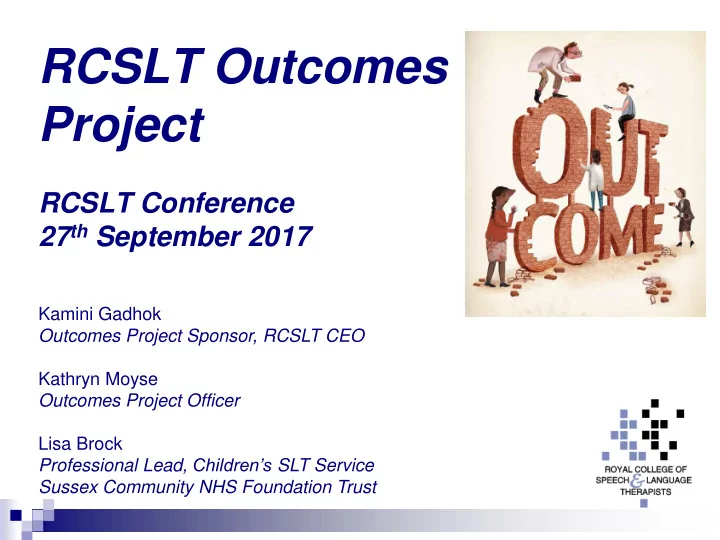

RCSLT Outcomes Project RCSLT Conference 27 th September 2017 Kamini Gadhok Outcomes Project Sponsor, RCSLT CEO Kathryn Moyse Outcomes Project Officer Lisa Brock Professional Lead, Children’s SLT Service Sussex Community NHS Foundation Trust
Session aims For RCSLT members to have an opportunity to hear about how outcomes data can support with: reflective practice for individual practitioners demonstrating the value of speech and language therapy to key stakeholders, including service users, budget- holders and decision-makers the delivery of quality speech and language therapy services 2
Why outcomes? 3
Challenges for the profession and beyond Outcome measures 4
The RCSLT Outcomes Project Initiated in 2013 to respond to drivers internal and external to the profession Comprises three key workstreams: Influencing national (UK wide) developments Phase 1: Identifying an existing outcome measure using ‘best fit’ criteria and proof of concept pilot Phase 2: Identifying the gaps, how to fill them and look at other work to be undertaken 5
RCSLT members’ ‘best fit’ criteria 6
Identifying an existing outcome measure Therapy Outcomes Measure (TOMs) (Enderby, John and Petheram, 2006) 1 was identified as the measure most fit for purpose It was acknowledged that: The adoption of TOMs was a starting point for the profession’s journey on outcome measurement TOMs would not be used as a ‘stand - alone’ option but employed alongside other outcome measures and other tools/frameworks TOMs is not applicable across all clinical areas and settings (e.g. universal services/Public Health) and parallel RCSLT work-streams would be established to consider how to fill these gaps in Phase 2 1 Third edition now available (Enderby and John, 2015) 7
Therapy Outcome Measures Enderby and John (2015) TOMs scales address four dimensions of an individual in line with the International Classification of Functioning, Disability and Health (WHO, 2007): Impairment - the severity of the presenting difficulty/condition Activity - the impact of the difficulty on the individual’s level of independence Participation – impact on levels of social engagement and autonomy Wellbeing – impact on mental and emotional wellbeing Each dimension is measured on an 11-point ordinal scale with six defined descriptors, ranging from 0 (worst case scenario), to 5 (best possible presentation). 8
Key ● Adult Phase 1 ● Paediatric pilot sites ● Adult and Paediatric 9
The RCSLT Online Outcome Tool The RCSLT Online Outcome Tool (ROOT) is being developed to support practitioners with: Collecting and collating outcomes data using two methods: • Data is entered directly into the ROOT Direct data entry • Data collected in local electronic systems is Data upload exported and uploaded to the ROOT Evaluating and reporting outcomes 10
Individual service user 11
Groups of service users
Applications of the reports Individual clinicians SLT teams/services “enabled quicker analysis “Easy to see patterns and a greater range of and where we are information and detail” actually having an impact on our clients’ lives” “We are starting to look at how/what area therapy benefits the clients” “It all makes doing TOMs more worthwhile “able to demonstrate to directorates and for everyone” management more detail regarding clinical outcomes and value of SLT”
Case study: Sample report Episodes = (450) Patients: (449) Figure 1: Report showing the direction of change in TOMs between initial and final ratings across each domain of TOMs (Impairment, Activity, Participation, and Well-being) for children with language disorder accessing speech and language therapy between July 2009 and July 2017 14
Total Completed Age Band Episodes Of Care 0 to 4 126 5 to 10 109 11 to 16 27 17 to 18 21 Under 18 283 19 to 30 230 31 to 40 239 41 to 50 591 51 to 60 1054 61 to 70 1702 71 to 80 2700 81 to 90 3139 90 plus 1087 Over 18 10742 Unknown 2677 Total 13702 15
Total Completed Episodes Of TOMs Scale Care Dysphagia 7773 Core Scale 1602 Dysphonia 943 Dysphasia 841 Dysarthria 516 Child Language Impairment 77 Learning Disability – Communication 76 Phonological Disorder 57 Cognition 52 Hearing Therapy/ Aural Rehabilitation 46 Autistic Spectrum Disorder 46 Dysfluency 43 Laryngectomy 37 Tracheostomy 32 Challenging Behaviour and Forensic Mental Health 10 Augmentative and Alternative Communication (AAC) 4 Dyspraxia – Developmental Coordination Difficulties 1 Head Injury 1 16
Phase 1 Evaluation Findings Using the ROOT to record and report on TOMs data is easy and efficient The data reports generated by the ROOT offer added value at a number of levels, including: Monitoring outcomes for individual service users and across specific clinical groups Evidencing the impact of SLT interventions Supporting service planning and quality improvement Providing intelligence to and influencing key stakeholders The ROOT has the potential to support with benchmarking
Phase 1 Evaluation Findings The pilot sites identified additional areas for development of the ROOT (e.g. additional core data fields in the ROOT to record data related to activity) Involvement with the pilot has had wider benefits for those taking part, including: a greater focus on outcomes from the start of the patient journey a greater appreciation of the value of data collection facilitating a shift away from the historical focus on inputs and outputs
What else have we learnt? 19
Where next? 20
Phased approach to implementation
What are the gaps? 22
Opportunities to get involved Contact kathryn.moyse@rcslt.org - RCSLT Outcomes Project Officer to: Find out more about the phased roll-out of the RCSLT Online Outcomes Tool and what you will need to do to be “ROOT - ready” Receive RCSLT Outcomes Project updates for more information and future opportunities to get involved Share your experiences of using outcome measures and local projects on outcomes and outcome measurement
ANY QUESTIONS?
For more information, please contact: Kathryn Moyse RCSLT Outcomes Project Officer kathryn.moyse@rcslt.org https://www.rcslt.org/members/outcomes/RCSLT_outcomes_project 25
Recommend
More recommend